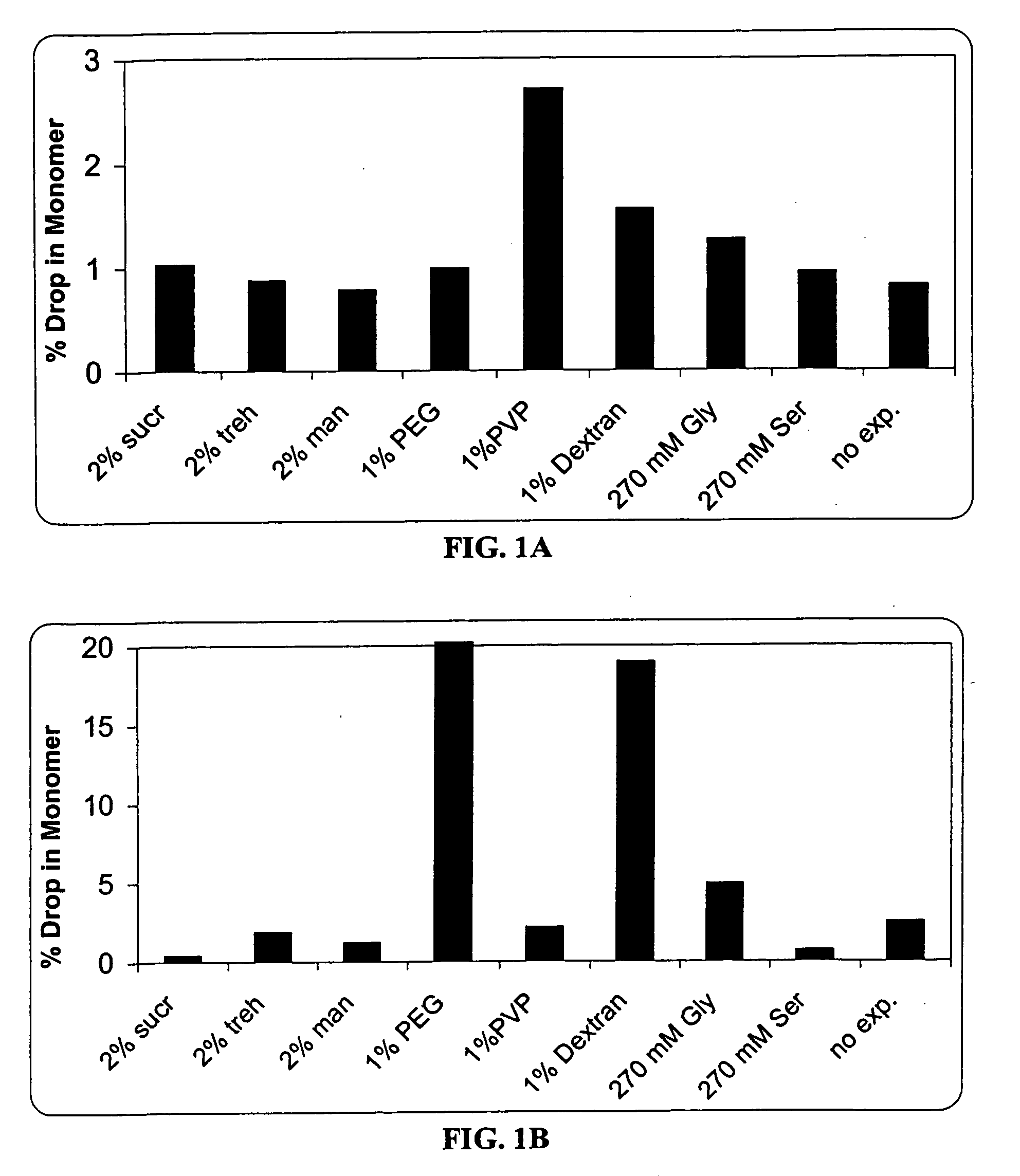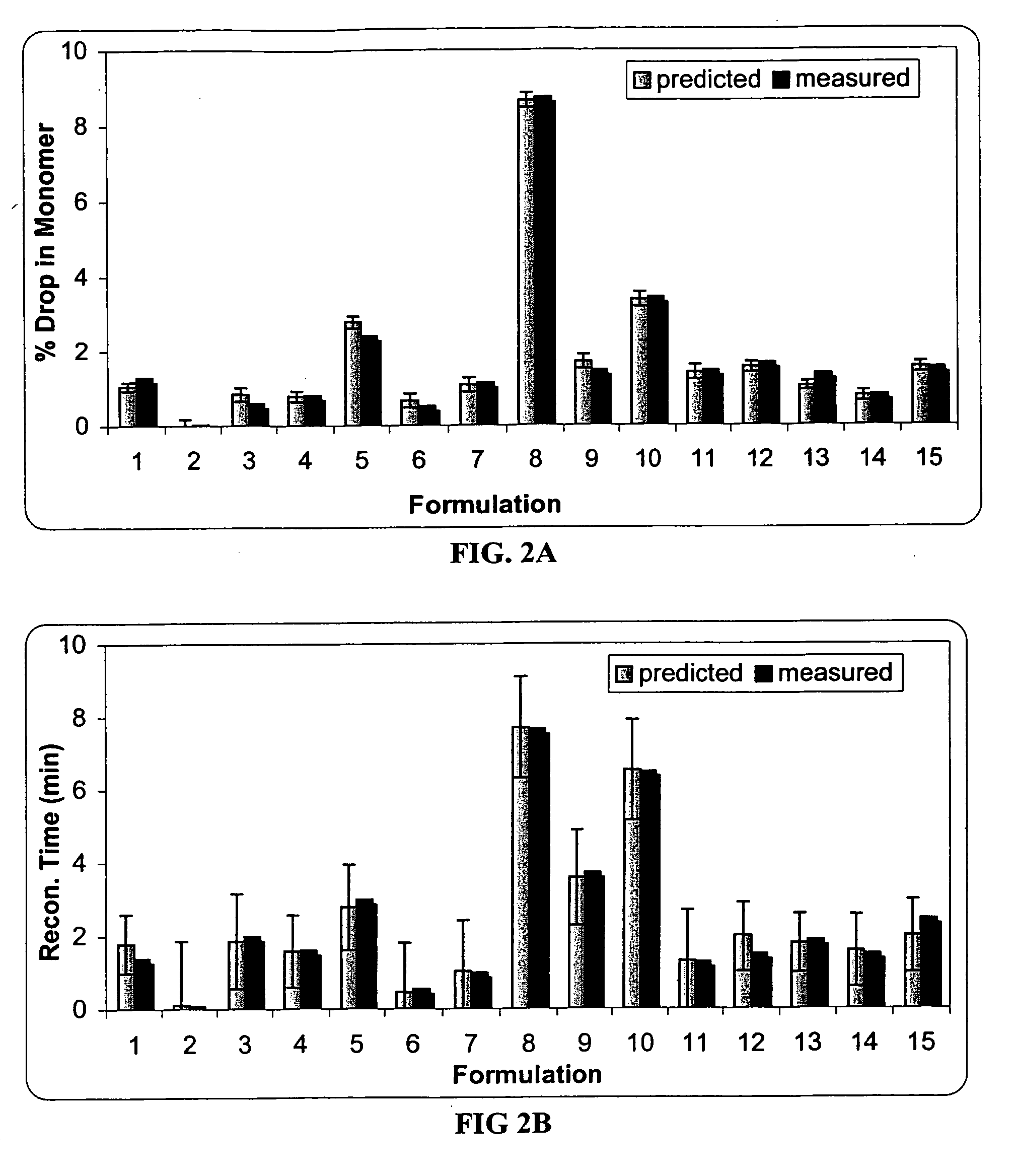Stable lyophilized pharmaceutical formulation of IgG antibodies
a technology of lyophilized and stable antibodies, applied in the direction of antibody medical ingredients, drug compositions, peptides, etc., can solve the problems of protein aggregates and particulates formation, many protein preparations are particularly unstable in very dilute or highly concentrated concentrations
- Summary
- Abstract
- Description
- Claims
- Application Information
AI Technical Summary
Benefits of technology
Problems solved by technology
Method used
Image
Examples
example 1
Procedures of Lyophilization
[0068] Vial configuration: 2 mL fill in 5 mL Wheaton vial;
[0069] Lyophilization Cycle: [0070] 1. Freezing: [0071] Temp: −40° C. [0072] Rate: 2° C. / min [0073] Freezing time: 3 hrs
[0074] 2. Primary drying: [0075] Temp: −20° C. [0076] Rate: 1° C. / min [0077] Duration: 12 hrs [0078] Pressure: 150 mTorr
[0079] 3. Secondary drying: [0080] Temp: 20° C. [0081] Rate: 1° C. / min [0082] Duration: 10 hrs [0083] Pressure: 150 mTorr
example 2
Preliminary Screening of Excipients
[0084] In this experiment, the formulation matrix contains 10 mg / ml anti-IL2 receptor antibody, 10 mM histidine, pH 6.0, and 0.015% Tween®80. The excipients screened includes (a) cryoprotectors / lyoprotectors such as sucrose, trehalose, polyethylene glycol (PEG), and polyvinylpyrrolidone (PVP); (b) bulking agents and tonicity modifiers such as mannitol, glycine, and serine; and (c) Tg enhancers such as dextran.
[0085] Two mL of each formulation was filled into a vial, and lyophilized by a conservative lyophilization cycle according to Example 1. Each lyophile was reconstituted with 2 mL of sterile water.
[0086] The accelerated stability test of each liquid formulation and each lyophile was performed at 55 or 40° C. The amounts of soluble aggregates was determined by SEC. The % monomer drop of different excipients was shown in FIG. 1.
[0087] The results indicated that PEG, dextran, and glycine decreased the pre-lyophilization liquid stability. The ...
example 3
Optimization of sucrose, mannitol and serine concentration.
[0089] The effect of sucrose, mannitol and serine on the protein stability was investigated using an I-Optimal (Hardin-Sloane) experimental design approach.
[0090] In this experiment, the formulation matrix contains 50 mg / ml anti-IL2 receptor antibody, 10 mM histidine, pH 6.0, and 0.015% Tween®80. The excipients screened include serine (0-100 mM), sucrose (0-120 mM) and mannitol (0-170 mM). The I-Optimal Design is shown as Table 1. Samples 1-15 are test formulations, and samples 16-20 are control formulations.
[0091] Two mL of each sample and control formulation was filled into a vial, and lyophilized according to the procedures described in Example 2. Each lyophile was reconstituted with 1 mL of sterile water. As the lyophile is reconstituted with only half the solution volume, osmolality and protein concentration are doubled.
TABLE 1I−Optimal Design TableSampleSerineSucroseMannitol10.029−0.029−0.08020.2361.0001.00031.00...
PUM
| Property | Measurement | Unit |
|---|---|---|
| concentration | aaaaa | aaaaa |
| pH | aaaaa | aaaaa |
| pH | aaaaa | aaaaa |
Abstract
Description
Claims
Application Information
 Login to View More
Login to View More - R&D
- Intellectual Property
- Life Sciences
- Materials
- Tech Scout
- Unparalleled Data Quality
- Higher Quality Content
- 60% Fewer Hallucinations
Browse by: Latest US Patents, China's latest patents, Technical Efficacy Thesaurus, Application Domain, Technology Topic, Popular Technical Reports.
© 2025 PatSnap. All rights reserved.Legal|Privacy policy|Modern Slavery Act Transparency Statement|Sitemap|About US| Contact US: help@patsnap.com



